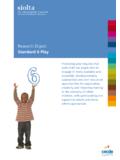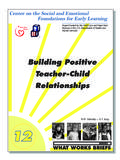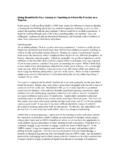Transcription of TECHNOLOGY-RICH INNOVATIVE LEARNING …
1 TECHNOLOGY-RICH INNOVATIVE LEARNING ENVIRONMENTS. Jennifer Groff February, 2013. INTRODUCTION. Our rapidly changing world has posed the long-standing question to education, How can today's schools be transformed so as to become environments of teaching and LEARNING that makes individuals lifelong learners and prepare them for the 21st Century?". The response to this question is the focus of the OECD project, INNOVATIVE LEARNING Environments, and has produced a sampling of the rich array of new visions for education around the world. As one might imagine, many LEARNING environments have looked to technology in their efforts to redesign teaching and LEARNING .
2 While technology integration has long been a key area of concern in education, the intersection of technology with our rapidly transforming educational landscape is framing the nature of technology in education in profound, new ways. New and emerging technologies are provoking a re-conceptualisation of teaching and LEARNING , while also serving as catalysts for transformation and innovation. Successfully preparing all learners with the skills and capacities for 21 st century citizenship . global awareness, creativity, collaborative problem-solving, self-directed LEARNING is no small order, and many educational leaders are finding that the traditional forms of education that have evolved through the end of the last century are simply inadequate for achieving these goals.
3 At the same time, while our outer world was transforming, considerable advances have been made in the LEARNING sciences, forcing educators to reconsider how they approach LEARNING , instruction, and the environments created to foster these. Finally, dramatic advances in educational technology have inspired powerful new ways for learners to engage with all kinds of content and activities in their own self-direct LEARNING experiences. The juxtaposition of these three events creates a very interesting challenge and opportunity a space to reconsider, re-imagine, and re-invent LEARNING environments able to prepare and excel each individual for effective life-long LEARNING .
4 THE DRIVE OF technology FOR SCHOOL CHANGE. While many, if not all, systems of education seek to at least improve and advance (and some even seek to radically transform), this does not necessarily mean one has to leverage technology to do so. However, there are several key drivers pushing technology as a key component for educational system change, and these serve as central reasons that educators and education stakeholders should consider 1. the growing relevance and implications of technology and technology -based school innovations (OECD, 2010): technology can perform several key functions in the change process, including opening up new opportunities that improve teaching and LEARNING particularly with the affordance of customisation of LEARNING to individual learner needs, which is highly supported by the LEARNING sciences.
5 The skills for an adult life include technological literacy, and people who do not acquire and master these competencies may suffer from a new form of the digital divide, which will impact their capacity to effectively operate and thrive in the new knowledge economy;. technology is an integral part to accessing the higher-order competencies often referred to as 21st Century Skills, which are also necessary to be productive in today s society. The New Millennium Learners (NML) work of the OECD over the last several years has contributed to these foundational elements, by describing the fundamental nature of learners in today s world. Increasingly connected, students today are constantly surrounded by a constellation of digital devices.
6 As described in this work, new millennium learners lives are highly dependent on technology up to the extent that their social and cultural practices would not be as they are if digital media were not available anytime, anywhere to them ; this body of work also describes the educational implications the NML research, explaining that students are not only accessing, managing, creating and sharing knowledge in dramatically different ways as their teachers often do, but also have radically new expectations regarding what a quality LEARNING experience should be . (Pedro, F., 2009, ). As a result, students are bringing attitudes, beliefs and perceptions to LEARNING environments around their own LEARNING experiences there, and the role that technology should play in it.
7 technology Use in Education and the New Digital Divide Alarmingly though, the PISA found that the frequency of ICT use at home is not paralleled by use at school, and in most OECD countries, more than 80% of 15 year-olds use computers frequently yet a majority do not use them much in school (OECD, 2010a). While most schools are equipped with computers and internet access, this disparity between school and home use is immense, and suggests that the old digital divide has been replaced with a new one those who can develop the appropriate competencies with ICT, often occurring outside of school. Much of this at-home use is oriented towards entertainment, suggesting there is an increasing role of schools to help learners engage with and leverage new technologies for LEARNING .
8 Exposure, access and fluency with ICT matters, as PISA. analysis demonstrates once socio-economic background is accounted for (OECD, 2010a). The Opportunity Once thought of as just a part of resources , we ve come to see how technology can be so much more than that. It can play a key role, and at times a leading role, in all elements of the teaching and LEARNING environment . technology can shape, and reshape, who is the learner and who is the teacher. It can open up knowledge and content that otherwise would be less accessible, through access to open educational resources for example. It obviously is part of resources , but it is clearly integral to the 2.
9 Organisation component insofar as it offers a critical mediating medium for those relationships of pedagogy and assessment inherent in organisation. The depth and breadth of technologies available today affords LEARNING environments much diversity and opportunity for leveraging ICT as a throughline for educational change. Intersecting that with the incredible array of LEARNING environments across the globe, we are left with a spectrum of examples of this thereby giving us a complex picture of what TECHNOLOGY-RICH LEARNING environments are, and could, be. UNESCO s Institute for Information technology has evaluated the degree to which ICT has been integrated in an educational system by applying Morel s Matrix a model that proposes an educational system moves between four distinct phases: (a) emerging, (b) applying, (c).
10 Integrating, and (d) transforming (UNESCO, 2003). A given LEARNING environment or education system can be mapped onto the matrix by being evaluated on various dimensions, such as content, pedagogy, curriculum, etc. (see Table 1). Table 1. Examples of Stages in Morel's Matrix (adapted from Centre for Research on Lifelong LEARNING , 2009). Criteria/Phase Emerging Applying Integrating Transforming limited, pragmatic, dominated by driven by ICTs driven-by subject entire LEARNING community Vision interested specialists specialists involved individuals teacher-centred; critical thinking; preferred LEARNING learner-centred;. teacher-centred ICTs are separate LEARNING styles.


















